Featured Golf News
Irish Golf Journey Continues at Storied Lahinch & Doonbeg
My lasting memory of Lahinch Golf Club is of the par-5 fourth hole, where a club employee emerged from a shack atop a 35-foot-high sand dune that blocked any view of the green on the reachable 475-yarder to serve as a target line and offer encouragement.
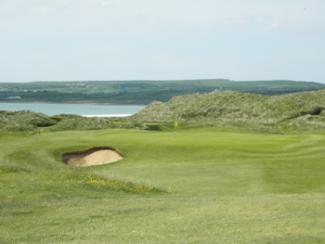
The 3rd Hole at Lahinch
The shelter is badly needed, of course, for rain and gale winds are common occurrences at Lahinch. That is, with the exception of this day, when it was 70 degrees, sunny and calm. As it was for our entire 10-day trip to Ireland, which had locals stunned.
"Do you realize we get about two days a year like this?" we were told following our Lahinch round. "If you had been here last week, you would have played with rain coming down sideways!"
By the time we reached Lahinch, our fifth course in five days, we were comparing the Irish weather to that in San Diego. "Just another typically perfect day," one of my traveling companions said.
Lahinch was playing as soft as possible, which didn't seem to help us much. Soft conditions are a relative term. The rough was still thick and penal, the greens were quick, the bunkers deep, and there were all sorts of inventive ways to find trouble.
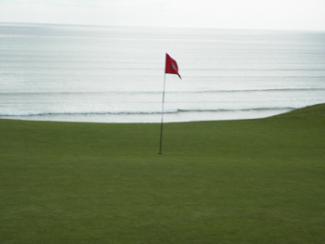
No. 7 at Lahinch
Lahinch is a classic links, with rolling terrain and dazzling seaside views from its dramatic, elevated tees. Blind shots abound. On the par-3 fifth, 30-foot sand dunes surround the green, shielding it from view from the tee. A stone on the hill provides the pin location. Known as "The Dell," this brilliant 154-yard hole was designed by Old Tom Morris in the 1890s and has remained untouched through the many changes undertaken at Lahinch over the ensuing decades.
It's easy to be struck by sensory overload at Lahinch, for there are marvelous sights to behold around every corner.
The par-5 second plays downhill toward the village, and members watch approach shots from the clubhouse deck, usually with a pint of Guinness in hand. The third hole requires a blind shot to an elevated fairway, followed by a downhill approach to a severely sloped green tucked against the sea.
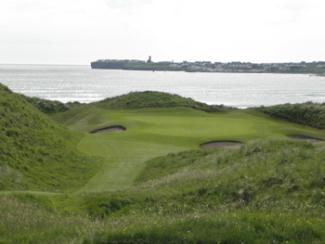
The 11th at Lahinch
The fourth, called "Klondyke," is another Morris specialty that hasn't changed in a century. The tee backs up against the ocean, while the fairway sits in a valley surrounded by sand dunes that provide complete isolation. The tee shot on the sixth is uphill and partially blind, with a downhill approach to another green with the ocean as a backdrop. The seventh? More challenges off the tee, more ocean views from the fairway and green.
So it goes at Lahinch. Little wonder that Stewart Cink once said, "The first 10 holes at Lahinch are some of the coolest links I have ever played."
The closing stretch includes brutally difficult back-to-back par-4s at 14 and 15 that check in at 461 and 466, respectively. Both demand precise drives to narrow fairways, followed by long approaches to well-protected greens.
Even on a calm day, Lahinch will wear you out. I can't imagine playing it in the rain and wind.
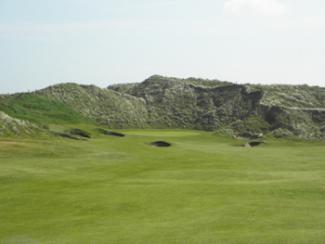
Doonbeg's Opening Hole
It's a short drive from Lahinch to Doonbeg Golf Club. On the day we arrived, news broke that a family dispute had resulted in the sale of the club to South Street Partners, an American investment firm. But you would never have known of such turmoil when we drove through the stone archway into a cobblestone courtyard surrounded by upscale cottages.
Situated on Doughmore Bay, the property is truly dazzling (and, one might add, expensive). There are jaw-dropping ocean views from 16 of the 18 holes as the course winds through 100-foot sand dunes and thick fescue. Six holes play directly against Doughmore Bay. Designed by Greg Norman and opened in 2002, Doonbeg has received numerous accolades, both for the beauty of the course and the spectacular amenities. It has also faced criticism for the penal rough and the difficulty of the green contours.
Norman made 23 visits to the site, which has the feel of a century-old links layout. Reportedly, the founders of Lahinch considered the site for their course in 1892, but decided the location was too remote. "When I first looked at the site, I thought I was the luckiest designer in the world," Norman said. He vowed not to Americanize the course, moving very little earth in creating the routing, which in traditional links fashion follows an out-and-back style. The result is a course that is both stunning and quirky.
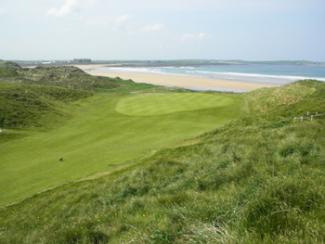
No. 5 at Doonbeg
The par-5, 560-yard opener is one of the finest I've ever played. Your eye is drawn to the nearby beach and dunes when standing on the elevated tee, while enormous dunes frame the fairway and three sides of the green. It provides a barometer of what's to come. The natural routing within the existing dunes results in an unusual combination of five par-3s and five par-5s for a par 72 of 6,911 yards.
Most unforgettable are the par-3s. The 175-yard ninth has the ocean on the left and three deep bunkers right. It sits in a valley of dunes. But the dramatic 14th is the most photographed. Only 111 yards off its elevated tee, the green is perched along the edge of a cliff, with its left side tucked into a dune. The view from the green toward the ocean and Doonbeg's stone clubhouse in the distance is unparalleled. Depending on wind conditions, you might hit anything from pitching wedge to 5-iron.
The 401-yard 12th is unique for a pot bunker that sits in the middle of the green, just one of the course's quirky aspects. The 11th hole includes a 15-foot-deep greenside bunker, while 500-yard 13th features a wall of four bunkers 150 yards off the tee, followed by an uphill approach to a green hidden behind dunes. The round closes with a dazzling and demanding 464-yard par-4 with the ocean running down the entire left-hand side of the hole.
For the most part, Norman got Doonbeg right.
Next: A visit to Ballybunion Golf Club, Waterville Golf Club and Old Head Golf Club.
Rob Duca is an award-winning sports columnist who wrote for the Cape Cod Times for 25 years, covering golf, the Boston Red Sox, the Boston Celtics and the Boston Bruins. He is now managing editor of Golf & Leisure Cape Cod magazine and has written for a variety of other publications, including Sports Illustrated, the Boston Globe, Yankee magazine and Cape Cod Life.
Story Options
 |
Print this Story |
